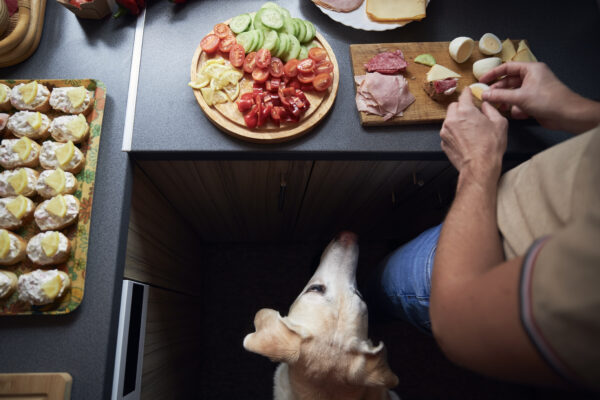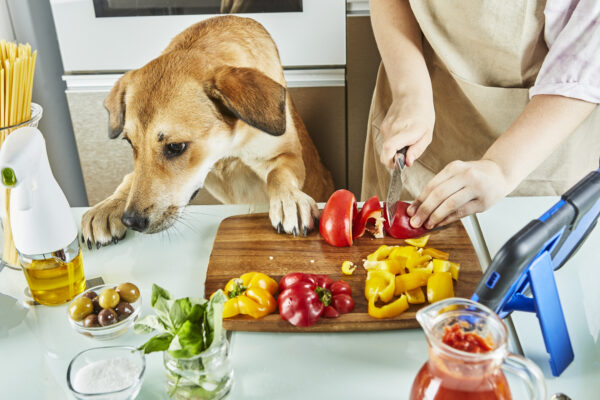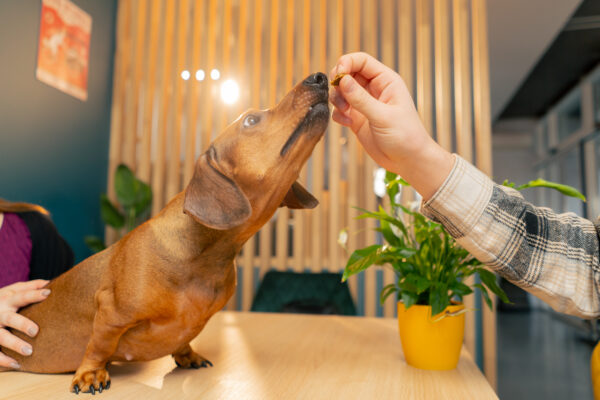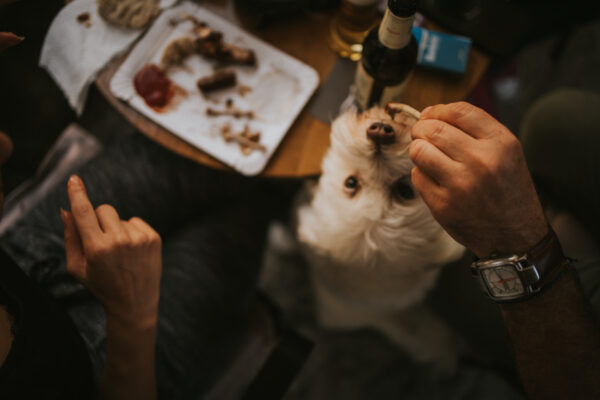p { font-size: 18px; line-height: 1.6; } table { width: 100%; border-collapse: collapse; margin: 20px 0; } table, th, td { border: 1px solid #2E8B57; } caption { font-weight: bold; margin-bottom: 10px; font-size: 20px; } th, td { padding: 12px; text-align: left; } h2, h3 { color: #2E8B57; } ul { margin-left: 20px; } a { color: #2E8B57; }
Can Dogs Eat Pickles? As a loving dog owner, you may find yourself tempted to share your favourite snacks with your furry friend. Pickles, with their tangy and crunchy appeal, are a popular human treat. But are they safe for dogs? This comprehensive guide explores the potential benefits and risks of feeding pickles to dogs. We delve into scientific research, veterinary advice, and real-life case studies to provide you with valuable insights. Read on to discover everything you need to know about dogs and pickles, ensuring you make informed decisions for your pet’s health and well-being.
Table of Contents
- 1. What Are Pickles?
- 2. Nutritional Value of Pickles
- 3. Can Dogs Safely Eat Pickles?
- 4. Potential Risks and Precautions
- 5. Types of Pickles and Their Effects on Dogs
- 6. Safe Alternatives to Pickles for Dogs
- 7. Case Studies and Expert Opinions
- 8. Frequently Asked Questions
- 9. Conclusion
1. What Are Pickles?
1.1 Definition and Process
Pickles are cucumbers that have undergone a pickling process, which involves preserving them in a brine solution. This solution typically consists of water, vinegar, salt, and various spices. The pickling process can involve fermentation, where beneficial bacteria develop, or simple marination. This process enhances the cucumber’s shelf life and imparts a distinctive sour, tangy flavour that many people enjoy.
1.2 Common Ingredients
Besides cucumbers, pickles often contain:
- Sodium (Salt): High levels are used for preservation and flavour enhancement.
- Vinegar: Provides acidity and acts as a preservative.
- Spices and Herbs: Such as dill, garlic, mustard seeds, cloves, cinnamon, and peppercorns.
- Sugar: Used in sweet pickles to balance acidity and add sweetness.
- Preservatives: Chemicals like sodium benzoate or calcium chloride to extend shelf life and maintain texture.
- Additives: Some pickles may contain artificial colors or flavors.
1.3 Cultural Variations
Pickles vary widely across cultures:
- Dill Pickles: Popular in the United States, flavored with dill weed.
- Kosher Pickles: Include garlic and are made in the traditional Jewish New York City style.
- Sweet Pickles: Contain sugar or sweeteners, often used in relishes.
- Indian Pickles: Known as “achar,” made with various fruits and vegetables, spices, and oils.
- Korean Kimchi: Fermented vegetables like cabbage and radish with spices; however, kimchi is spicy and not suitable for dogs.
2. Nutritional Value of Pickles

2.1 Nutritional Breakdown
While fresh cucumbers are low in calories and rich in essential nutrients, the pickling process significantly alters their nutritional profile. The addition of salt, vinegar, and spices changes both the macro and micronutrient content.
Below is the nutritional content of one medium dill pickle (~35g) (USDA, 2021):
| Nutrient | Amount |
|---|---|
| Calories | 4 kcal |
| Protein | 0.2 g |
| Total Fat | 0 g |
| Carbohydrates | 0.8 g |
| Sodium | 283 mg |
| Fibre | 0.3 g |
| Vitamin K | 14.4 µg |
| Potassium | 47 mg |
2.2 High Sodium Content
One of the most significant nutritional changes in pickles is the elevated sodium level due to the brining solution. For humans, moderate sodium intake is manageable, but for dogs, high sodium can be harmful. A single medium pickle contains approximately 283 mg of sodium, which is substantial considering a dog’s recommended daily sodium intake.
2.3 Comparison with Fresh Cucumbers
To understand the impact of pickling, let’s compare the nutritional content of a medium fresh cucumber (~301g):
| Nutrient | Amount |
|---|---|
| Calories | 45 kcal |
| Protein | 1.9 g |
| Total Fat | 0.3 g |
| Carbohydrates | 10.9 g |
| Sodium | 6 mg |
| Fiber | 1.5 g |
| Vitamin K | 49.4 µg |
| Potassium | 442 mg |
The fresh cucumber has significantly lower sodium and higher levels of beneficial nutrients like potassium and vitamin K.
3. Can Dogs Safely Eat Pickles?

3.1 The Short Answer
While small pieces of plain pickles may not be immediately toxic to dogs, it’s generally not recommended to feed pickles to your canine companion due to potential health risks associated with high sodium and harmful ingredients.
3.2 Understanding Canine Dietary Needs
Dogs require a balanced diet that provides appropriate amounts of proteins, fats, carbohydrates, vitamins, and minerals. Their bodies are not designed to handle high levels of sodium or certain spices commonly found in pickles. Feeding foods outside their nutritional needs can lead to health complications.
3.3 Veterinary Consensus
Most veterinarians advise against feeding pickles to dogs. According to Dr. Amy Flowers, DVM, “The risks associated with feeding pickles to dogs often outweigh any potential benefits. High sodium intake and the presence of toxic ingredients like garlic and onions make pickles an unsuitable snack for dogs.”
3.4 Exceptions and Special Cases
In rare cases, a veterinarian may recommend a small amount of pickle juice to address specific health issues like electrolyte imbalances. However, this should only be done under direct veterinary supervision.
4. Potential Risks and Precautions

4.1 High Sodium Intake
Excessive sodium can lead to:
- Sodium Ion Poisoning: Also known as hypernatremia, symptoms include vomiting, diarrhea, tremors, seizures, and even death in severe cases. Dogs are more sensitive to sodium than humans, and their bodies cannot process large amounts efficiently.
- Increased Blood Pressure: Chronic high sodium intake can lead to hypertension, which strains the heart and arteries.
- Dehydration: High sodium levels cause the body to pull water from cells to balance sodium levels in the bloodstream, leading to excessive thirst and urination.
- Kidney Damage: The kidneys work to filter excess sodium, and over time, this can lead to renal issues.
4.2 Harmful Ingredients
Pickles may contain ingredients toxic to dogs:
- Garlic and Onions: Members of the Allium family, these can cause hemolytic anemia by damaging red blood cells. Symptoms may not appear immediately and can include weakness, lethargy, pale gums, and rapid breathing.
- Spices: Spices like chili peppers or mustard seeds can cause gastrointestinal irritation, leading to vomiting, diarrhea, and abdominal pain.
- Artificial Preservatives: Chemicals like sodium benzoate may not be well-tolerated and can cause allergic reactions or digestive upset.
- Sugar and Artificial Sweeteners: Sweet pickles may contain high sugar levels or artificial sweeteners like xylitol, which is highly toxic to dogs and can cause hypoglycemia, seizures, and liver failure.
4.3 Gastrointestinal Upset
The acidity from vinegar and spices can irritate a dog’s stomach lining, leading to discomfort, vomiting, and diarrhea. Dogs have a different pH balance in their digestive systems compared to humans, making them more susceptible to irritation from acidic foods.
4.4 Allergic Reactions
Some dogs may have allergies or sensitivities to certain ingredients in pickles, resulting in symptoms like itching, hives, swelling, and even anaphylactic reactions in severe cases. Identifying the specific allergen can be challenging due to the combination of ingredients in pickles.
4.5 Behavioral Considerations
Feeding human foods like pickles can encourage begging behavior and lead to dietary imbalances if the dog begins to prefer these over their regular food. Consistency in feeding routines is crucial for maintaining a healthy diet.
4.6 Case Study: Sodium Ion Poisoning
Buddy, a 5-year-old Labrador Retriever, consumed an entire jar of pickles left unattended on the kitchen counter. Within a few hours, he exhibited symptoms of vomiting, excessive thirst, disorientation, and seizures. His owners rushed him to the emergency veterinary clinic, where he was diagnosed with sodium ion poisoning. Buddy required intensive treatment, including intravenous fluids to correct electrolyte imbalances and medications to control seizures. After several days of hospitalization, Buddy recovered, but the incident highlights the severe dangers of high sodium intake in dogs.
4.7 Financial Implications
Emergency veterinary care can be costly. In Buddy’s case, the medical expenses exceeded $2,500. Preventing access to harmful foods not only safeguards your dog’s health but also avoids unexpected financial burdens.
5. Types of Pickles and Their Effects on Dogs

5.1 Dill Pickles
Risk Level: Moderate to High
Dill pickles are flavoured with dill weed and often contain garlic. The dill herb itself is not toxic and can even have health benefits for dogs in small amounts. However, the inclusion of garlic and high sodium levels makes dill pickles risky.
5.2 Sweet Pickles
Risk Level: High
Sweet pickles contain added sugars, which can contribute to obesity and dental problems. Some sweet pickles may also contain xylitol, an artificial sweetener that is highly toxic to dogs. Xylitol ingestion can cause rapid insulin release, leading to hypoglycemia (low blood sugar), seizures, liver failure, and even death.
5.3 Kosher Pickles
Risk Level: High
Kosher pickles are known for their strong garlic flavor. Garlic is toxic to dogs and can cause hemolytic anemia. Additionally, the high sodium content poses added risks.
5.4 Bread and Butter Pickles
Risk Level: High
These pickles are sweet and often contain onions, which are toxic to dogs. The combination of high sugar, onions, and spices makes them particularly hazardous.
5.5 Pickled Vegetables
Risk Level: Variable
Other pickled items like onions, beets, or peppers can be toxic due to their inherent properties and the pickling ingredients. For example, pickled onions are highly toxic, while pickled beets contain high sugar and sodium levels.
5.6 Fermented Pickles vs. Vinegar Pickles
Fermented Pickles: Made through a natural fermentation process, these pickles contain probiotics, which are beneficial bacteria. While probiotics can be good for gut health, the high sodium and potential spices still make them unsuitable for dogs.
Vinegar Pickles: Made by soaking cucumbers in vinegar and spices. The high acidity and sodium content can irritate a dog’s digestive system.
5.7 Visual Table: Pickle Types and Risks
| Pickle Type | Main Ingredients | Risk Level | Potential Hazards |
|---|---|---|---|
| Dill Pickles | Cucumbers, dill, garlic, salt, vinegar | Moderate to High | High sodium, garlic toxicity |
| Sweet Pickles | Cucumbers, sugar, spices, vinegar | High | High sugar, possible xylitol |
| Kosher Pickles | Cucumbers, garlic, salt, dill, vinegar | High | Garlic toxicity, high sodium |
| Bread and Butter Pickles | Cucumbers, sugar, onions, spices | High | High sugar, onion toxicity |
| Pickled Vegetables | Varies (onions, peppers, etc.) | Variable | Toxic vegetables, spices |
| Fermented Pickles | Cucumbers, salt, water, spices | Moderate to High | High sodium, spices |
6. Safe Alternatives to Pickles for Dogs
6.1 Fresh Cucumbers
Fresh cucumbers are safe and hydrating for dogs when given in moderation. They are low in calories and contain beneficial nutrients:
- Low in Calories: Approximately 16 calories per cup, making them suitable for weight management.
- Hydrating: Composed of about 95% water, they help keep your dog hydrated.
- Vitamins and Minerals: Contains vitamin K (for blood clotting and bone health), vitamin C (immune support), and potassium (muscle function).
Serving Suggestions: Wash thoroughly, peel if waxed, and cut into bite-sized pieces to prevent choking. Avoid adding any seasoning or salt.
6.2 Other Dog-Friendly Vegetables
- Carrots: Good for dental health as they help clean teeth while chewing. Rich in beta-carotene, which supports eye health.
- Green Beans: Low in calories and high in fiber, vitamins A, C, and K. Can be given raw or cooked (without seasoning).
- Sweet Potatoes: Cooked and unseasoned; high in vitamins A, B6, and C, as well as fiber. Supports digestive health.
- Broccoli: In small amounts; rich in vitamins and fiber. Overfeeding can cause gas or gastrointestinal upset.
- Pumpkin: Cooked and plain; excellent for digestive health due to its high fibre content.
6.3 Fruits Safe for Dogs
- Apples: Remove seeds and core; high in fiber and vitamins A and C. Promote dental health.
- Blueberries: Rich in antioxidants, vitamin C, and fiber. It is good for immune support.
- Bananas: In moderation; high in potassium, vitamins, and fiber. Good for heart and muscle function.
- Watermelon: Seedless and rindless; hydrating and rich in vitamins A and C.
6.4 Homemade Dog Treats
Consider making homemade treats using dog-safe ingredients. This allows you to control what goes into your dog’s snacks, ensuring they are healthy and free from harmful additives.
Example Recipe: Peanut Butter and Pumpkin Dog Treats
- Ingredients: Whole wheat flour, canned pumpkin (plain), peanut butter (xylitol-free), eggs.
- Instructions: Mix ingredients, roll out dough, cut into shapes, and bake.
6.5 Case Study: Switching to Healthy Alternatives
Lily, a 6-year-old Poodle, used to beg for pickles whenever her owner snacked on them. Concerned about the risks, her owner consulted a veterinarian and began offering fresh cucumber slices instead. Lily enjoys the crunchy snacks without any adverse effects, and her owner has peace of mind knowing she’s providing a safe and healthy treat.
6.6 Benefits of Safe Treats
Providing safe alternatives ensures:
- Nutritional Benefits: Adds variety and nutrients to your dog’s diet.
- Weight Management: Low-calorie options help maintain a healthy weight.
- Dental Health: Crunchy vegetables like carrots can promote dental hygiene.
- Behavioral Training: Healthy treats can be used as rewards during training sessions.
7. Case Studies and Expert Opinions
7.1 Veterinary Insights
Dr. Jennifer Coates, DVM, emphasizes, “While a small piece of pickle might not harm your dog immediately, the high sodium content and potential toxic ingredients make it an unwise choice. It’s better to stick with safer alternatives that provide nutritional benefits without the risks.”
7.2 Statistical Data on Sodium Toxicity
A study published in the Journal of Veterinary Internal Medicine found that sodium toxicosis accounted for approximately 2% of all poisoning cases in dogs, with a mortality rate of 15% (JVIM, 2015). This highlights the seriousness of sodium poisoning and the importance of preventing high sodium intake.
7.3 Real-Life Example: Garlic Toxicity
Max, a 4-year-old Beagle, developed hemolytic anemia after consuming garlic-infused pickles. He showed signs of weakness, lethargy, and pale gums a few days after ingestion. Blood tests revealed a low red blood cell count. Max required blood transfusions and intensive care. His recovery took several weeks, and the medical expenses were substantial, exceeding $4,000. This case underscores the severe risks associated with garlic ingestion in dogs and the delayed onset of symptoms, making early detection challenging.
7.4 Survey Data on Human Food Ingestion
A survey conducted by the American Pet Products Association found that 63% of dog owners admit to feeding their pets table scraps, with 29% unaware of the potential risks. Education on safe feeding practices is essential to prevent accidental poisoning and health issues.
7.5 Expert Recommendations
The American Veterinary Medical Association (AVMA) advises pet owners to be cautious with human foods and to consult veterinarians when introducing new foods to pets. They emphasize that foods high in sodium, fat, or containing toxic ingredients should be avoided.
8. Frequently Asked Questions
Q1: Can dogs eat pickles without spices?
A: Even plain pickles without spices still contain high sodium levels, which can be detrimental to your dog’s health. While a small piece may not cause immediate harm, it’s best to avoid feeding pickles altogether to prevent potential health issues.
Q2: What should I do if my dog ate a pickle?
A: Monitor your dog for any signs of distress such as vomiting, diarrhea, excessive thirst, lethargy, or changes in behavior. If you notice any symptoms or if your dog consumed a large quantity, contact your veterinarian immediately. Provide details about the type of pickle and the amount consumed to assist in assessment and treatment.
Q3: Are there any benefits to feeding pickles to dogs?
A: Pickles offer minimal nutritional benefits to dogs and come with significant risks due to high sodium and potential toxic ingredients. The potential harm outweighs any minor benefits from vitamins or minerals present. It’s better to provide safe, nutrient-rich alternatives.
Q4: Can puppies eat pickles?
A: No, puppies have more sensitive digestive systems and are more susceptible to the harmful effects of high sodium and toxic ingredients. Feeding pickles to puppies can lead to severe health complications. Stick to veterinarian-recommended puppy foods and treats designed to meet their nutritional needs.
Q5: Are pickle juices safe for dogs?
A: No, pickle juice is high in sodium and often contains spices and vinegar, which can irritate your dog’s digestive system and lead to sodium ion poisoning. Ingesting pickle juice can be more harmful than eating a pickle due to the concentrated levels of sodium and other additives.
Q6: Can dogs eat fermented foods?
A: Some fermented foods like plain yogurt or certain probiotics can be beneficial for dogs’ gut health. However, fermented vegetables like sauerkraut or kimchi are high in sodium and spices, making them unsuitable for dogs. Always consult your veterinarian before introducing fermented foods into your dog’s diet.
Q7: Is vinegar harmful to dogs?
A: In small amounts, vinegar is not toxic to dogs but can cause gastrointestinal upset due to its acidity. Large quantities or concentrated forms should be avoided. Some pet owners use diluted vinegar solutions for cleaning or as a deterrent for certain behaviors, but ingestion should be minimized.
Q8: Can dogs have low-sodium pickles?
A: Even low-sodium pickles may contain other harmful ingredients like garlic, onions, or spices. Additionally, “low-sodium” does not mean “no sodium,” and the levels may still be higher than what’s safe for dogs. It’s best to avoid feeding any type of pickle to your dog.
Q9: Why does my dog seem interested in pickles?
A: Dogs are often curious about human foods due to their smell and the social aspect of eating together. The crunchy texture and strong scent of pickles may attract them. However, interest does not equate to safety, and it’s important to refrain from sharing foods that may harm them.
Q10: How can I prevent my dog from accessing pickles or other harmful foods?
A: Store pickles and other human foods securely in cabinets or the refrigerator, out of your dog’s reach. Use child-proof locks if necessary. Be cautious during meal times and avoid leaving food unattended on tables or countertops. Educate family members and guests about not feeding your dog table scraps or unauthorized treats.
9. Conclusion
While the occasional small piece of plain pickle may not immediately harm your dog, the potential risks associated with high sodium content and toxic ingredients like garlic and onions make pickles an unsuitable snack for canines. Feeding pickles to your dog can lead to serious health complications, including sodium ion poisoning, hemolytic anemia, and gastrointestinal distress. It’s safer and more beneficial to offer your dog alternative fruits and vegetables known to be safe and nutritious.
Always consult your veterinarian before introducing new foods into your dog’s diet. By making informed decisions and providing safe, healthy treats, you can ensure your furry friend remains happy and healthy. Remember, your dog’s health and well-being are paramount, and it’s worth taking the extra time to choose appropriate snacks.
At Flawless Cuties, we’re committed to providing you with reliable information and high-quality products to keep your pets safe and healthy. Explore our range of nutritious dog treats and supplements that are both safe and delicious.
Can I Pet That Dog? A Comprehensive Guide to Safe and Enjoyable InteractionsObedience Puppy Training: A Step-by-Step GuideTop 10 Best Dog Breeds for Apartments: A Comprehensive GuideThe Best Homemade Dog Food Recipes: A Comprehensive GuideI Don’t Want to Hit My Dog, But I Want Them to Obey – What Should I Do? Here’s How to Train Your Dog Positively
Recommended Safe Treats for Your Dog
Check out these veterinarian-approved treats:
References
- Pet Poison Helpline. (n.d.). Salt Poisoning in Dogs. Retrieved from https://www.petpoisonhelpline.com/poison/salt/
- American Society for the Prevention of Cruelty to Animals (ASPCA). (n.d.). People Foods to Avoid Feeding Your Pets. Retrieved from https://www.aspca.org/pet-care/animal-poison-control/people-foods-avoid-feeding-your-pets
- Journal of Veterinary Internal Medicine (JVIM). (2015). Sodium toxicosis in dogs, 29(5), 1377-1383. doi:10.1111/jvim.12526
- United States Department of Agriculture (USDA). (2021). FoodData Central: Pickles, cucumber, dill or kosher dill. Retrieved from https://fdc.nal.usda.gov/fdc-app.html#/food-details/169719/nutrients
- PetMD. (n.d.). Can Dogs Eat Pickles? Retrieved from https://www.petmd.com/dog/nutrition/can-dogs-eat-pickles
- Coates, J. (2020). The Dangers of Feeding Your Dog Table Scraps. Retrieved from https://www.pethealthnetwork.com/dog-health/dog-diet-nutrition/dangers-feeding-your-dog-table-scraps
- ASPCA Animal Poison Control Center. (n.d.). Garlic. Retrieved from https://www.aspca.org/pet-care/animal-poison-control/toxic-and-non-toxic-plants/garlic
- Hand, M. S., et al. (2010). Small Animal Clinical Nutrition (5th ed.). Mark Morris Institute.
- Richardson, J. A. (2000). Management of poisoning in dogs and cats. Australian Veterinary Journal, 78(5), 323-329. doi:10.1111/j.1751-0813.2000.tb11756.x
- American Pet Products Association (APPA). (2019). National Pet Owners Survey. Retrieved from https://www.americanpetproducts.org/
- AVMA. (n.d.). Pet Food Safety. Retrieved from https://www.avma.org/resources-tools/pet-owners/pet-food-safety
- Buffington, C. A. T., et al. (2004). Nutrition and disease. In Hand, M. S., et al. (Eds.), Small Animal Clinical Nutrition (5th ed., pp. 501-528). Mark Morris Institute.



















